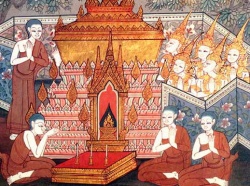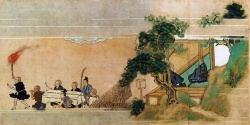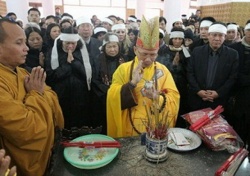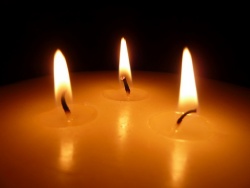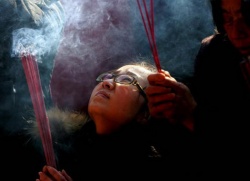Of funerals and death anniversaries: Burmese traditions and Chinese rites
This August, my grandma passed away, shortly after she turned 90. Despite how emotionally prepared we thought we were, it was still a bittersweet occasion.
With that said, I thought I would provide a glimpse into some traditions and rituals performed during Chinese Buddhist funeral services and Burmese death anniversaries. A major feature of many Chinese rites is food. Funeral services are no exception. However, in comparison to Taoist rites, Buddhist rites are very solemn affairs devoid of ostentation (i.e. no gold paper or hell note burning). n a Chinese Buddhist service, food is ritually offered (變食真言) to the deceased and to the Buddhas on a table, placed in front of an image of the 3 Mahayana Buddhas/Bodhisattvas and an ancestral tablet (牌位, Buddhist ones are specifically called 往生蓮位). At the direction of the nun at a Burmese Chinese temple (中緬佛教傳佈協會), my aunts prepared bowls of rice, Chinese dishes, fruits, along with a pair of chopsticks and napkin, and 3 cups of tea for both the viewing and the service. After being brought to the burial site for another round of bows, these foods are not consumed (instead, they were left at the burial site).
Every funeral attendee was also offered a red envelope filled with a coin (to be used before returning home), a piece of red string (to be tied on one’s finger to prevent spirits from following one home) and a sweet candy (to counteract the bitterness of death). Before we left the funeral site, we were instructed not to look back at the coffin, perhaps to detach ourselves further. Afterward, all the funeral attendees were invited for a banquet at a vegetarian Chinese restaurant (Happy Veggie Garden), keeping in line with Chinese Buddhist practices. For inner circle descendants (including children, daughters-in-law and grandchildren of the sons), traditional Chinese protocol calls for a mourning period of 49 days, with funerary rites performed every 7 days, led by my eldest uncle. A major prohibition during this time is on visiting other people’s homes.
About two Sundays ago, my family held a one month death anniversary to mark my grandma’s death at a local monastery, Parami Buddha Vihara. Burmese traditions regarding the dead are pretty vague. Perhaps the result of orthodox Buddhist beliefs, rituals that fortify one’s attachment to the dead are frowned upon. Ancestor veneration isn’t practiced in Burma (unlike in neighboring Thailand and Cambodia). However, death anniversaries, commemorated in the form of ahlu ceremonies, are commonplace, seen as ways to continue the legacy of performing good deeds. My family held one at the 1 month mark, exactly 31 days after my grandma’s death. As I’ve written before, ahlu celebrations are community affairs. The donor family arranges a massive feast at a monastery to embody the Buddhist spirit of dana (translated as giving alms or charity). Neighbors, friends, family, coworkers, and acquaintances of all sorts are invited for these events. A few of my Hispanic neighbors even came out to celebrate! My aunt took charge of preparing the massive feast. Cooking 50 pounds of catfish in a huge cauldron for the mohinga, wrapping 500 perfect samosas. Anybody who’s cooked mohinga or samosas knows that these are no easy feats. There’s a science to cooking mohinga. Like most Burmese dishes, mohinga has very earthy flavors and textures–it’s delicate and subtly flavorful. Mohinga is a very common dish in Burma and uses a variety of ingredients, including catfish, lemongrass, banana trunk,and vermicelli. The broth base is made of chickpea flour (which gives mohinga its distinctive color), seasoned with fish sauce, turmeric and fish paste.
Also, since the soup base was cooked the night before, great care had to be taken to allow the soup’s different components to settle properly. A film of oil that develops at the top effectively protects the soup from spoiling; any disruption to this thin membrane will cause it to spoil. Throughout the cooking and serving process, the cauldron has to be continuously stirred, to allow the individual components to heat up.
A stack of mohinga ah-phat (the body of the soup)
The body of mohinga soup assembled in advance so it doesn’t get hectic when the hungry attendees arrive.
The noodle soup uses boiled rice vermicelli (called aphat) and is eaten with boiled duck eggs and fried pea fritters (pe kyaw), garnished with coriander and chili powder to one’s liking. There is, of course, some regional variation. People from the Bago countryside (like my dad) like to eat mohingawith fresh tomato slices. As with a lot of Burmese dishes, the dish can be eaten with or without the meaty soup base. The latter is basically a vegetarian salad.
Mohinga was served with a side dish of Burmese-style samosas (more technically, samuza), deep-fried dumplings filled with seasoned potatoes. Burmese samosa differ from their Indian counterparts in that Burmese ones are folded like flat triangles. No meal is complete without dessert! For dessert, we served up a variety of cakes and fruits. Burmese dessert cakes are rather similar to Malaysian/Indonesian kuih. Among the desserts were cassava cake (pureed cassava and condensed milk with a gelatinous texture), shwe htamin (sweetened glutinous rice and jaggery garnished with coconut shavings), poppy seed shortcake, and split coconut milk and pandan gelatin.
As I’ve surely mentioned before, Theravada Buddhist monks refrain from eating after noon time. They are offered a separate meal (usually including more entrees not offered to the attendees) before everyone else is fed, out of respect. There’s a uniquely Burmese ritual of lifting the entire table to formally offer the food (Thais normally offer a dish at a time) to the monk. The Burmese language has specialized vocabulary used to distinguish laymen and clergy, something that gets lost in translation when I write about this. For instance, I (or any civilian for that matter) would eat htamin, whereas a Buddhist monk would eat hsun. Another major facet of ahlu celebrations is to raise money for the monastery. With the help of my 2 younger cousins, I manned the “donation department,” basically a table set up to allow attendees to conveniently donate money. Throughout the day, a steady stream of donations came in, meaning a lot of work writing receipts, inputting into an Excel spreadsheet and verifying the totals. At the end of the day, we collected over $2,000 in donations, a pretty impressive success.
At 1 pm, everyone was called to attend the sermon led by the resident monk, Ashin Paññādipa. He had a rather compelling argument to make about the importance of everyday effort and focus. But I won’t get into that, as this is not a blog on Buddhist philosophy. At the end of the talk was the obligatory water libation ceremony (yay zet cha), which wrapped up the celebration. While the monk chanted, the primary donors (usually the eldest males in the family) meticulously poured water from a vessel to bowl. Not really sure what the origins of this practice are, but it’s a standard practice also found among Thai Buddhists.
Afterward was the massive cleanup effort to return the monastery to its original state, as the kids for Sunday school arrived. We hired 2 helpers to help out with putting the tables and chairs away, cleaning the restrooms, washing pots and utensils, etc, since it was a lot of work. Despite the tremendous amount of work put into holding this feast, everything went hummingly smooth. An astounding success on all accounts, all done in the memory of our beloved an-ma. May you rest in peace. As the Burmese would say, “Sadhu! Sadhu! Sadhu!”
Peace,
Justin
